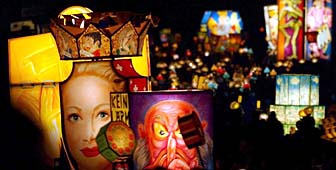Crowds jam Basel streets for Fasnacht

Tens of thousands of people turned out before dawn to celebrate the start of the ancient and colourful carnival of carnivals in Basel.
The city lights were extinguished, as “Morgestraich” began, and an immense parade kicked off Basel’s three most festive days of the year, known as Fasnacht.
Masked drummers and piccolo players marched through the city’s streets and alleys at 4am on Monday, their path lit solely by brightly painted lanterns hoisted on wagons or poles, like the banners medieval troops once carried into battle.
Crowds parted as the marchers wound through the city’s Old Town, and many of the spectators fell in line behind them, to join their march through the streets.
In the packed squares, the spectators found the lanterns mesmerizing, as the drumming cliques moved toward, then past them.
Morgestraich is only one of many peculiar customs of Basel’s carnival that make it the most unique and popular in Switzerland, drawing throngs of spectators each year.
Morgestraich also marks the culmination of months of behind the scenes preparations for the well-rehearsed and extremely well organised event.
Lifting the Mask
Long-time participant Peter Habicht has written an English guide to Fasnacht, called “Lifting the Mask”. He wrote the book to unravel the strange customs of Basel’s carnival and reveal why it can be funny and serious at the same time.
“Every carnival has its rules, I’m convinced,” Habicht says.
The book illuminates the origin of the lanterns – painted with comic motifs, the traditional Fasnacht costumes and masks, and unravels the tangled web of Fasnacht groups like the “cliques” who wear them. Habicht also attempts to make some sense of the satirical verses, known as “Schnitzelbängg”, sung in the local dialect during Fasnacht.
“The plural of Schnitzelbangg is Schnitzelbängg. Those who sing Schnitzelbängg are Schnitzelbänggler. Everything clear?” Habicht asks in the book.
Certainly not, but Lifting the Mask is an indispensable guide for anyone wanting to understand the story behind Basel’s three-day revelry. It even includes a chapter on traditional Fasnacht recipes like flour soup and tips on where best to experience the festival.
Schyssdräggziigli
Many of the smaller groups, known as the Schyssdräggziigli, loosely (and politely) translated as formations of little importance, often gather in the beautiful old square known as Andreasplatz.
“We come here to have a break,” says Habicht, a member of one of these groups himself.
“When you take your mask off, you see other people you know and you have a chat and exchange news,” he says. “You say ‘how wonderful this Fasnacht is and have you seen this lantern, and have you seen that clique and have you seen this mask and isn’t that great!'”
Some carnival goers create their own disguises, but most have them made in shops specialising in Fasnacht masks.
A cottage industry has developed around Fasnacht. Every one of the thousands of participants wears a mask and costume, and most of them play a musical instrument.
10,000 piccolo players
In the weeks leading up to Fasnacht, the queues get longer at the mask shops where each of the disguises is made by hand, costing anywhere between SFr200 and SFr500.
And Habicht says there are about 10,000 piccolo players in Basel alone, thanks mainly to Fasnacht. Each Fasnacht clique has its own music school where the next generation of piccolo players or drummers learn traditional marches.
Broken or out of tune piccolos are taken to the city’s music shops. One in particular, “Musik Oesch”, has struck a note with 95 per cent of all the people who play the instrument at Fasnacht.
The father and son who run the shop spend each night in the weeks leading up to the carnival visiting the Cliques in their club cellars to help them tune their instruments.
Lampoon lanterns
Final preparations for Fasnacht include the groups’ choice of “Sujet”, displayed on the painted lanterns. The Sujet lampoons a newsworthy event from the past year, whether tragic or humorous.
“Basel Fasnacht has this rather severe, not sinister, but severe and grave tone to it,” Habicht explains.
“This is part of the fascination, it is not just loud and funny – it is very funny, very funny indeed – but it has this seriousness. It’s a mixture which I think is one of the aspects that make Fasnacht in Basel unique.”
His book also includes a list of “do’s and don’ts” for Fasnacht spectators. “I recommend you leave your fake nose and your silly hat at home and don’t paint your face,” he warns.
Fasnacht, Habicht realises, has changed with the times but he wants it to be saved from the ravages of globalisation.
“We’re losing our traditions. This might be one of the reasons why I wrote the book,” he says.
“Because I know that in order to keep the tradition alive it must change. It is constantly changing, but we must not commercialise it because everything in this world has been commercialised, and everything is the worse for it, and it loses its spirit.”
by Dale Bechtel

In compliance with the JTI standards
More: SWI swissinfo.ch certified by the Journalism Trust Initiative

You can find an overview of ongoing debates with our journalists here. Please join us!
If you want to start a conversation about a topic raised in this article or want to report factual errors, email us at english@swissinfo.ch.